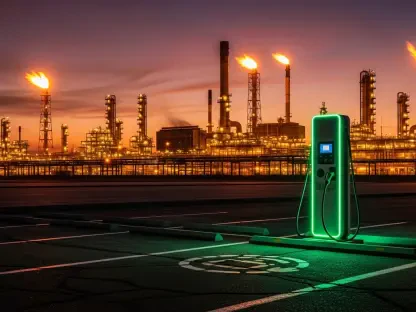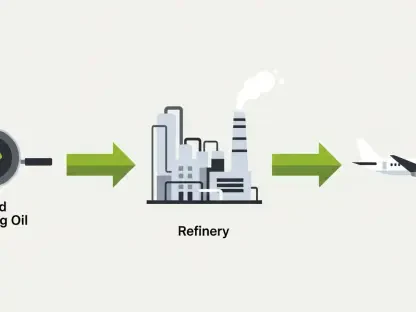The recent surge of interest in solid-state battery technology signals a transformative phase in energy storage solutions. As the world grapples with the imperatives of sustainable energy and the strategic independence of technological supply chains, solid-state batteries are emerging as pivotal elements in addressing these needs. These innovations promise significant advancements in energy density and operational safety, qualities that are especially vital in applications ranging from consumer electronics to national defense. The University of Texas at Dallas’s BEACONS facility, with considerable backing from the U.S. Department of Defense, exemplifies efforts to enhance national security through technological self-reliance, spotlighting solid-state solutions.
Intricacies of Solid-State Batteries
Solid-state batteries stand apart due to their use of solid electrolytes as opposed to the liquid or gel-based ones found in traditional lithium-ion batteries. This foundational shift promises enhanced energy density, due to the electrolyte’s stability, and marked improvements in safety, as it virtually eliminates risks like electrolyte leakage or combustion. The technology has roots in the late 20th century but has gained momentum recently with technological refinements and increased demand for high-performance energy solutions. Its relevance in the modern electronics and energy storage sectors is underscored by industries’ growing reliance on efficient and safe battery technologies.
The incorporation of solid electrolytes is central to the design advantages of solid-state batteries. This component not only facilitates the transport of ions between the anode and cathode but does so with enhanced thermal and chemical stability. Researchers have explored various types like ceramic and glass electrolytes, each presenting distinct performance characteristics and challenges. The pursuit of electrolytes combining high ion conductivity with stability marks an ongoing focus in enhancing performance metrics.
Moreover, these batteries boast a significant improvement in energy density, holding the potential for extended device operation without increasing size or mass. Safety remains another compelling feature, as solid electrolytes mitigate the flammability risks associated with traditional batteries. Collectively, these features render solid-state batteries an attractive proposition for next-generation technology applications.
Innovations Shaping Solid-State Battery Landscape
Recent years have seen unparalleled innovations in solid-state battery technology, characterized by incremental and breakthrough advancements. Notably, the BEACONS facility highlights the strategic importance of fostering domestic innovation while collaborating internationally on critical materials sourcing. The Pentagon’s directive to wean off certain Chinese-sourced lithium-ion batteries by 2027 has spurred accelerated research and robust commercialization strategies.
Emerging trends reveal a shift in industry focus towards optimizing scalability and manufacturability, crucial for widespread adoption. Researchers and manufacturers continue to experiment with novel materials and electrolytes, aiming to enhance battery life and reduce production costs—factors critical to competitiveness in multiple sectors.
Strategic Applications and Implementations
Solid-state batteries now find themselves integral to numerous industries, with automobile manufacturers among their most enthusiastic adopters. Electric and hybrid vehicles benefit from the enhanced range and safety profiles of these batteries. Meanwhile, electronics, particularly portable devices, leverage these advancements for improved performance and user experience.
A notable implementation involves defense operations, where solid-state batteries are deployed to power critical systems, reducing operational risks while maximizing efficiency. Their potential to radically improve energy storage capabilities extends into aerospace, medical devices, wearables, and beyond, paving the way for groundbreaking technological applications.
Overcoming Challenges in Adoption
Despite their promise, solid-state batteries face technical and regulatory hurdles impeding widespread adoption. Manufacturing complexities, particularly economies of scale, limit rapid market penetration. Moreover, regulatory landscapes must evolve to accommodate emerging standards and ensure product safety.
Industry stakeholders are actively engaged in addressing these challenges. Advancements in mass production techniques are underway, while researchers innovate to lower costs and increase accessibility. International collaborations on materials sourcing represent strategic moves to bolster capabilities and secure supply chains.
Future Prospects and Industry Influence
The trajectory of solid-state battery technology suggests promising developments and potential breakthroughs. As research surfaces new materials and configurations, performance and cost-effectiveness take center stage. These advancements hold potential to reshape entire industries, with long-term impacts on energy consumption, mobile computing, and transportation.
Looking ahead, solid-state batteries offer opportunities for energy sustainability and strategic independence. Their widespread deployment could revolutionize how energy is stored and used, contributing significantly to reduced carbon footprints and enhanced energy security.
Overall Evaluation
In conclusion, solid-state battery technology stands at the forefront of innovative energy solutions, poised to redefine multiple industry landscapes. With significant strides in safety, energy density, and sustainable practices, their impact on defense and consumer markets is profound. As the technology aligns with strategic initiatives like those demonstrated by the BEACONS facility, it promises to secure energy futures while fostering economic growth through domestication of critical technologies. As these advancements continue, a transformative era for energy storage and utilization emerges, charting new courses for technological progress.









